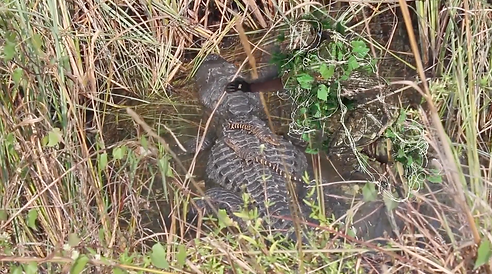

CAMOUFLAGE
Camouflage is the use of a combination of materials, coloration, or illumination for concealment, either by making animals or objects hard to see, or by disguising them as something else. Animals utilize camouflage for a number of reasons to do with self preservation. Both the predator and the prey can benefit from invisibility.
Dakota Gearhart is an interdisciplinary artist who deals with topics of science and technology with an ecofeminist lens. Her collage process embraces the glitch that happens when video clips are chroma-keyed and layered. Most of Gearhart’s other work is cluttered, chaotic, and overtly sexual. Body Curtain is surprisingly tender. In the video, the artist dresses in haphazard camouflage and is superimposed on top of scenes with resting and dead animals. In some scenes, the camouflage mimics the foliage of the scene the animal is in, while in others, the artist dresses in the colors of the animal. The camera is pointed downward, and the viewer watches her crawl over to the animals and caress and snuggle with them. Gearhart uses this camouflage to get physically and emotionally close to these animals. The work speaks to creating intimate connections with the animal/other by assimilating into its environment.
As the path of least resistance in the human social environment, a trans person may choose to apply gender camouflage in the form of clothing, makeup, and hormones to assimilate. When a trans person is “unclockable” and does not disclose their transness, within the trans community they are referred to as “stealth”. Blending into the social environment provides not only safety but also satisfaction for some. For most binary trans people, blending into the social environment as an apparent cisgender person is the goal.

Dakota Gearhart, Body Curtain, 12:30 Video, 2017